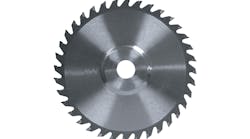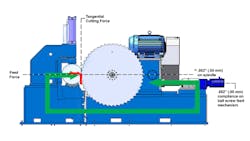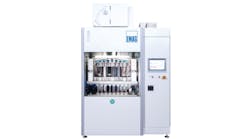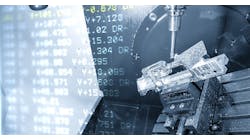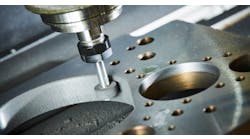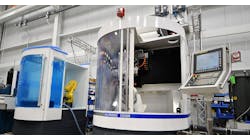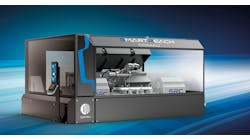Carbide saws equipped with carbide or coated cermet-tipped blades are designed to cut extremely hard materials. The effectiveness of the blade depends to a great degree on the way that the saw is built.
The relatively brittle carbide or cermet tips require very rigid and backlash-free machines, operating with low vibration to avoid cracking of the cutting tips and to ensure an equal chip load on each tooth of the saw blade. This is especially important with the spindle drive. The spindle drive gears must have low backlash and must be supported by preloaded, heavy-duty bearings to minimize vibration. The same is true with the blade feed mechanism and the head slide or pivot mechanism.
Generally, there are two types of saws — slide-type or pivot-type saws — differentiated by the way the blade is fed into the work piece. The more common saws are slide-type machines, where the head slide can be arranged in a vertical, horizontal or angular position. The preloaded slide can glide on box ways or preloaded linear ways. Experts still argue whether box ways using low-friction lining and hydraulically preloaded way clamps have a better dampening effect than linear ways with hardened balls, rollers, and blocks.
Simpler Arrangement
Pivot-type saws are simpler, have fewer components and, if properly designed with oversized taper roller bearings, can be made very rigid by preloading the pivot bearings to the limits. Built for extreme stiffness, a pivot mechanism for the spindle gearbox would be nested in a rigid base close to the floor, fed by a heavy-duty ball screw attached to an upper sub-assembly, such as the fixture frame. The spindle is located between the pivot point and the feed mechanism. Due to the feed force and the center of gravity of the head, the ball screw is always under tension, which eliminates the need for a preloaded ball screw and provides a very positive feed for interrupted cutting, enhanced longevity and efficiency.
This arrangement provides a closed-loop force distribution because closed frames are stiffer than open profiles. Subsequently, it also reduces the remaining deflection of the feed mechanism due to the ratio of ball screw and spindle in relation to the pivot point, and it contains the cutting forces within the machine structure.
Compared to a standard slide machine (illustrated in Figure 1), a pivot machine would be stiffer and less expensive. Pivot saws are built to saw material up to 24 in. (600 mm) stock size and have proven themselves in various standard and special saw systems.
Circular carbide-tipped blades are limited to a maximum of 80-inch blade diameter and therefore will cut only materials that are up to about 30-inches diameter. However, circular carbide saws have a much higher cutting volume per minute than carbide-tipped band saws. In this range up to 30-inch material, carbide saws using circular blades really shine.
Willy Goellner is the CEO of Advanced Machine & Engineering, Rockford, IL, a manufacturer and supplier of the AMSAW line of sawing machines, material handling equipment, and blades.
